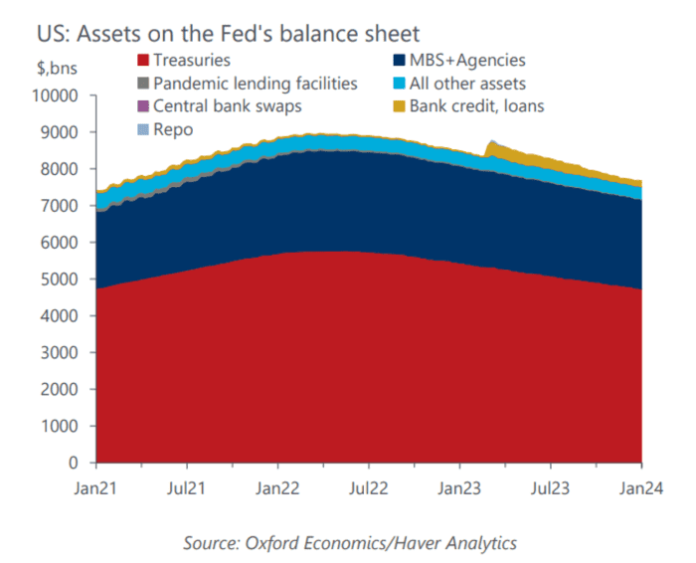Investors are eager to hear more on Wednesday about when the Federal Reserve might pivot to lower interest rates.
But that won’t be the only focus after the central bank’s two-day policy meeting. Another big concern on Wall Street centers on what plans the Fed has for its roughly $7.7 trillion balance sheet, especially if its size keeps rapidly shrinking and puts the financial plumbing of markets at risk.
The Federal Reserve should reconsider how quickly it lets is balance sheet shrink, before it cause plumbing issues in the financial system, says John Canavan, an analyst at Oxford Economics.
Oxford Economics, Haver Analytics
To stave off potential plumbing issues that could affect the flows of credit and capital, John Canavan, a lead analyst at Oxford Economics, said Monday that he thinks the Fed will reduce how quickly its balance sheet shrinks in the second quarter, and for the unwinding to end in the second half of 2024.
The Fed has been allowing $60 billion of Treasury securities and up to $35 billion in agency mortgage-backed securities roll off its balance sheet each month. That has resulted in a balance sheet that is $1.3 trillion smaller than its record size of nearly $9 trillion in the wake of the pandemic.
Related: Pimco spots opportunity in mortgages as Fed considers when to stop shrinking its balance sheet
Dallas Fed President Lorie Logan seized Wall Street’s attention in early January when she said the Fed should slow its balance-sheet shrinkage when overnight reverse repo balances fall to a low level.
That left many in markets to fixate on when a “low level” might be achieved, while the central bank also keeps “ample” reserves in the system to keep it functioning smoothly. Fed officials have indicated a desire to avoid a repeat of the September 2019 repo crisis, when overnight lending rates surged to a peak of 10% by some estimates.
Mark Cabana and BofA Global’s rates research team, who sounded alarms ahead of the 2019 repo stress, said Friday they expect Fed officials at this week’s policy meeting to discuss “when” and “how” to engineer “a more orderly transition from an abundant to ample reserve regime.” But they also expect more details on those discussions to emerge when minutes of the January meeting are released.
Balance-sheet shrinkage at the Fed has helped drain excess pandemic liquidity from markets. But the Fed’s overnight reverse repurchase program, a proxy for excess liquidity, also could near a zero balance in three months, according to Canavan. That should have the Fed on high alert to act quickly before trouble surfaces.
“Once RRP balances are drained, Treasury issuance, which will likely include increases to coupon auction sizes, will require new sources of cash,” Canavan said. “Bank reserves should then decline as banks and other investors use the cash held in bank reserves to purchase the debt.”
Stocks rallied Monday, with the Dow Jones Industrial Average
DJIA
and S&P 500 index
SPX
both setting their sixth record closes of the year, after the Treasury Department said it expects to borrow $760 billion in the first quarter, which is $55 billion lower than previously estimated.
The yield on the benchmark 10-year Treasury note
BX:TMUBMUSD10Y
also fell, sinking 7 basis points to 4.089%, its biggest daily yield decline in about a month, according to Dow Jones Market Data.
Related: The Fed may be ‘patient’ in cutting rates, says portfolio manager at Morgan Stanley
www.marketwatch.com
https://www.marketwatch.com/story/why-analysts-say-the-fed-risks-clogging-the-financial-plumbing-without-a-policy-change-953c9385















